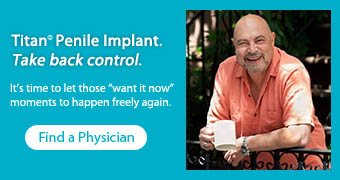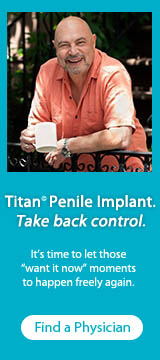Removal of Corpus Cavernosum or not?
Apparently, some time before the mid-nineties removal/destruction of the Corpus Cavernosum tissue (the erectile meterial inside the tunica albuginea being replaced by the penile implant's inflatable tubes) was routinely performed (to make room for the implant?) as the "Standard of Care".
Since then, researchers are finding this to be unnecessary and even counter-productive with regard to safety (infection control-shorter operation time), recovery time, patient discomfort during recovery and sexual satisfaction after recovery. Yet, not all surgeons attempt preservation despite the fact that abandoning the practice also made the surgery easier.
I read a study where (in first-time implantees) "use of the Hagar Dilator" was used in a control group of men to remove or destroy a man's Corpus Cavernosum tissue as was the standard practice. In the comparison group of men, the tissue was preserved, resulting in the above-described benefits with no observed ill effects.
Does anyone know the history of the this part of the implant operation, when the practice of removing the erectile tissue was changed and is preservation now the Standard of Care or not?
These articles piqued my interest:
(Sorry, I don't have the links handy, but searching on the titles should bring them up, either here in the forum where I posted links before or in the broader internet.)
Inflatable Penile Prosthesis Implantation Without Corporeal Dilation: A Cavernous Tissue Sparing Technique Ignacio Moncada,* Juan Ignacio Martínez-Salamanca, José Jara, Ramiro Cabello, Mercedes Moralejo and Carlos Hernández From the Departments of Urology and Andrology, Hospital La Zarzuela (IM) and Hospital Universitario “Gregorio Marañón” (JJ, RC, MM, CH) and Department of Urology, Hospital Universitario “Puerta de Hierro” (JIMS) Madrid, Spain
Sorry, I don't have the abstract.
Strategies for Maintaining Penile Size following penile implant., Translational Andrology and Urology: Androl Urol 2013 March
Sorry, I don't have the abstract.
Spontaneous and prolonged drug-induced erection in a patient with inflatable penile implant.
Yildirim I1, Aydur E, Tahmaz L, Irkilata HC, Seçkin B, Peker AF.
Andrologia. 2007 Apr;39(2):71-2.
Abstract
Achievement of spontaneous tumescence after penile implant surgery has already been reported. However, regular spontaneous full, rigid erection upon sexual arousal that is adequate for vaginal penetration and tumescence for satisfactory sexual performance is an extremely rare condition in men with three-piece hydraulic implants. Similarly, prolonged erection is not expected in such implant cases even with the use of erectogenic agents. We report this interesting phenomenon confirmed by magnetic resonance imaging technique in a patient with inflatable device.
Hollow and Fenestrated Penile Prosthesis: A New Implant for Treatment of Impotence
Article in Archives of Andrology 38(1):93-8 · January 1997 with 51 Reads
DOI: 10.3109/01485019708988536 · Source: PubMed
Abstract
Penile implants are used for erectile dysfunction (ED). Their main disadvantage is that the cavernous tissue is destroyed and replaced by fibrous so that implant replacement is difficult and the penis loses its erectile function permanently. This paper describes a novel prosthesis which is hollow and fenestrated to preserve, as much as possible, the cavernous tissue. The fenestrated implant was used in 18 men with ED, while the solid Small-Carrion implants were used in 14 impotent men who matched the 18 men in age and cause of impotence and acted as controls. Routine erectile function tests suggested that the ED was neurogenic. The fenestrated prosthesis was a hollow semisolid silicone rod with multiple openings (2-3 mm in diameter) along its whole length. The mean follow up of the patients was 43 /- 12 SD months. No complications were encountered. Vaginal penetration was successful in the fenestrated and Small-Carrion implant groups. A total of 14/18 patients of the fenestrated prosthesis group experienced spontaneous erections upon sexual arousal, while none of the Small-Carrion prosthesis group did. During the sexual act the penis became tumescent in the patients of the former group but not in those of the latter. It is suggested that the residual cavernous tissue after insertion of the hollow fenestrated implant regenerates through the fenestrae into the implant lumen. This might explain the spontaneous erections upon sexual arousal and the tumescence during the sexual act, but this hypothesis remains to be proved histologically.
Removal of Corpus Cavernosum or not?
-
Lost Sheep
- Posts: 6144
- Joined: Mon Jul 04, 2016 11:16 pm
Removal of Corpus Cavernosum or not?
Lost Sheep
AMS LGX 18+3 Nov 6, 2017
Prostate Cancer 2023
READ OLD THREADS-ask better questions -better understand answers
Be part of your medical team
Document pre-op size-photos and written records
Pre-op VED therapy helps. Post-op is another matter
AMS LGX 18+3 Nov 6, 2017
Prostate Cancer 2023
READ OLD THREADS-ask better questions -better understand answers
Be part of your medical team
Document pre-op size-photos and written records
Pre-op VED therapy helps. Post-op is another matter
Re: Removal of Corpus Cavernosum or not?
Lost Sheep wrote:Removal of Corpus Cavernosum or not?
Apparently, some time before the mid-nineties removal/destruction of the Corpus Cavernosum tissue (the erectile meterial inside the tunica albuginea being replaced by the penile implant's inflatable tubes) was routinely performed (to make room for the implant?) as the "Standard of Care".
Since then, researchers are finding this to be unnecessary and even counter-productive with regard to safety (infection control-shorter operation time), recovery time, patient discomfort during recovery and sexual satisfaction after recovery. Yet, not all surgeons attempt preservation despite the fact that abandoning the practice also made the surgery easier.
I read a study where (in first-time implantees) "use of the Hagar Dilator" was used in a control group of men to remove or destroy a man's Corpus Cavernosum tissue as was the standard practice. In the comparison group of men, the tissue was preserved, resulting in the above-described benefits with no observed ill effects.
Does anyone know the history of the this part of the implant operation, when the practice of removing the erectile tissue was changed and is preservation now the Standard of Care or not?
These articles piqued my interest:
(Sorry, I don't have the links handy, but searching on the titles should bring them up, either here in the forum where I posted links before or in the broader internet.)
Inflatable Penile Prosthesis Implantation Without Corporeal Dilation: A Cavernous Tissue Sparing Technique Ignacio Moncada,* Juan Ignacio Martínez-Salamanca, José Jara, Ramiro Cabello, Mercedes Moralejo and Carlos Hernández From the Departments of Urology and Andrology, Hospital La Zarzuela (IM) and Hospital Universitario “Gregorio Marañón” (JJ, RC, MM, CH) and Department of Urology, Hospital Universitario “Puerta de Hierro” (JIMS) Madrid, Spain
Sorry, I don't have the abstract.
Strategies for Maintaining Penile Size following penile implant., Translational Andrology and Urology: Androl Urol 2013 March
Sorry, I don't have the abstract.
Spontaneous and prolonged drug-induced erection in a patient with inflatable penile implant.
Yildirim I1, Aydur E, Tahmaz L, Irkilata HC, Seçkin B, Peker AF.
Andrologia. 2007 Apr;39(2):71-2.
Abstract
Achievement of spontaneous tumescence after penile implant surgery has already been reported. However, regular spontaneous full, rigid erection upon sexual arousal that is adequate for vaginal penetration and tumescence for satisfactory sexual performance is an extremely rare condition in men with three-piece hydraulic implants. Similarly, prolonged erection is not expected in such implant cases even with the use of erectogenic agents. We report this interesting phenomenon confirmed by magnetic resonance imaging technique in a patient with inflatable device.
Hollow and Fenestrated Penile Prosthesis: A New Implant for Treatment of Impotence
Article in Archives of Andrology 38(1):93-8 · January 1997 with 51 Reads
DOI: 10.3109/01485019708988536 · Source: PubMed
Abstract
Penile implants are used for erectile dysfunction (ED). Their main disadvantage is that the cavernous tissue is destroyed and replaced by fibrous so that implant replacement is difficult and the penis loses its erectile function permanently. This paper describes a novel prosthesis which is hollow and fenestrated to preserve, as much as possible, the cavernous tissue. The fenestrated implant was used in 18 men with ED, while the solid Small-Carrion implants were used in 14 impotent men who matched the 18 men in age and cause of impotence and acted as controls. Routine erectile function tests suggested that the ED was neurogenic. The fenestrated prosthesis was a hollow semisolid silicone rod with multiple openings (2-3 mm in diameter) along its whole length. The mean follow up of the patients was 43 /- 12 SD months. No complications were encountered. Vaginal penetration was successful in the fenestrated and Small-Carrion implant groups. A total of 14/18 patients of the fenestrated prosthesis group experienced spontaneous erections upon sexual arousal, while none of the Small-Carrion prosthesis group did. During the sexual act the penis became tumescent in the patients of the former group but not in those of the latter. It is suggested that the residual cavernous tissue after insertion of the hollow fenestrated implant regenerates through the fenestrae into the implant lumen. This might explain the spontaneous erections upon sexual arousal and the tumescence during the sexual act, but this hypothesis remains to be proved histologically.
I've not asked my doctor, and even I'm having a hard-time getting the bloody pump to work, I can tell you that I still experience a mediocre morning blood follow similar to the one I had prior to my implant. So my guess is that I my doctor did not remove my Corpus Cavernosum.
Re: Removal of Corpus Cavernosum or not?
My understanding is that the corpus cavernosum are not removed, but since they are rather "spongy," they are kind of "squished" (ending their ability to cause a natural erection) so the implant cylinders can be inserted. (I am not a medical professional, so this is just what my understanding has been.)
-
radioradio
- Posts: 1012
- Joined: Tue Aug 09, 2016 2:44 pm
- Location: Philly Burbs
Re: Removal of Corpus Cavernosum or not?
David_R wrote:My understanding is that the corpus cavernosum are not removed, but since they are rather "spongy," they are kind of "squished" (ending their ability to cause a natural erection) so the implant cylinders can be inserted. (I am not a medical professional, so this is just what my understanding has been.)
Exactly my understanding, too.
Bob
2.2
Born '52. Married '79. RALP 3/1/17. ED 50+% prior to surgery even w/ meds. VED, Injections, ineffective. Considering implant even before PCa diagnosis. Dr. Kramer 8/2/17. LGX 21cm+0.5 RTE. Kramer replaced/repositioned pump 12/13/17. Willing to Show/Tell.
Re: Removal of Corpus Cavernosum or not?
I had my implant done in 1993, now that it has died, my penis is like a bit of loose skin hanging there, so they must have taken all of mine. Getting the new one on Monday, am feeling a bit anxious, going from AMS700, to Titan.
AMS 700cx (18cm) implanted 1993,failed Aug 2017, Surgeon Professor Peter Heathcoat, Brisbane. Revision done on 16-10-17 with Titan (22+1) Surgeon A/Professor Eric Chung, Brisbane. I live on the Sunshine Coast, Queensland, Australia. Borne 1951.
-
Lost Sheep
- Posts: 6144
- Joined: Mon Jul 04, 2016 11:16 pm
Re: Removal of Corpus Cavernosum or not?
David_R wrote:My understanding is that the corpus cavernosum are not removed, but since they are rather "spongy," they are kind of "squished" (ending their ability to cause a natural erection) so the implant cylinders can be inserted. (I am not a medical professional, so this is just what my understanding has been.)
That is logical and apparently was the conventional wisdom until 1997 or so when studies showed that some erectile function still remained IF (and that is important) the cavernosum tissue is not too damaged (either by disease or by the implant surgery itself).
There is no guarantee of retained function, but medical science has been learning by experience since the beginning of medical science. Before, it was thought that destruction of the tissue was inevitable and assumed that the tissue was non-functioning in any event. The past 25 years has shown that in some cases (50% or more) erectile function can be retained (and in a few cases it has been seen, improved) after an implant. The improvements it is speculated may be because of compression of of the veins that drain the penis may reduce venous leakage.
Research has shown that it is clear that erectile function is not guaranteed to be lost upon implant.
Medical science moves ahead and conventional wisdom is often corrected as we learn more.
I might look forward to the day when impotence caused by venous leakage could be treated, instead of an implant, a venous sphincter that would be a LOT less invasive than an implant, reservoir, pump and valve assembly.
So, I respectfully disagree.
Lost Sheep
AMS LGX 18+3 Nov 6, 2017
Prostate Cancer 2023
READ OLD THREADS-ask better questions -better understand answers
Be part of your medical team
Document pre-op size-photos and written records
Pre-op VED therapy helps. Post-op is another matter
AMS LGX 18+3 Nov 6, 2017
Prostate Cancer 2023
READ OLD THREADS-ask better questions -better understand answers
Be part of your medical team
Document pre-op size-photos and written records
Pre-op VED therapy helps. Post-op is another matter
-
rockyrocky
- Posts: 24
- Joined: Sat May 27, 2017 3:04 am
Re: Removal of Corpus Cavernosum or not?
Interesting topic
Any tissue removed during surgery has to be sent to the Pathology Department for examination. You cannot just throw it away.
The examination is a visual/gross examination and microscopic examination if needed. Since I didn't receive a bill from the Pathology Department at the University of Maryland I am assuming no tissue was removed during the penile implant procedure.
Any tissue removed during surgery has to be sent to the Pathology Department for examination. You cannot just throw it away.
The examination is a visual/gross examination and microscopic examination if needed. Since I didn't receive a bill from the Pathology Department at the University of Maryland I am assuming no tissue was removed during the penile implant procedure.
69 y/o. Radical prostatectomy April 30,2017. Penile implant July 19, 2017 Dr Kramer University of Maryland. Titan 22cm plus 2.5 cm RTE
-
Donnie1954
- Posts: 2518
- Joined: Wed Feb 19, 2014 9:04 pm
- Contact:
Re: Removal of Corpus Cavernosum or not?
My Urologist said no tissue was removed during my procedure. He said he inserted the implant into my penis. I have regained some erectile function and stiffen slightly when physicality or visually stimulated but not hard enough for intercourse.
Donnie
Donnie
Implant AMS 700 CX, MS (18cm x 12mm with 5.5cm RTEs) on 10\4\16. 64 Dr. Edward Kata of Orlando. Awesome surgeon. Check out, 'DD Bryan. My implant journey, Wit and Wisdom, Stretching routine, Implant Pics, Natural Hang. Live in Ga.
.
.
Re: Removal of Corpus Cavernosum or not?
ddbryan1972 wrote:I have regained some erectile function and stiffen slightly when physicality or visually stimulated but not hard enough for intercourse
Same here.
Re: Removal of Corpus Cavernosum or not?
ddbryan1972 wrote:My Urologist said no tissue was removed during my procedure. He said he inserted the implant into my penis. I have regained some erectile function and stiffen slightly when physicality or visually stimulated but not hard enough for intercourse.
Donnie
Same here Donnie
68,Titan Touch 22cm+1.5cm rte's op done in Melbourne Aust by Dr Chris Love-Feb 2017 Venous leakage over a 2 year period, did pills and Caverject. Length@ 3 1/2years is: 7+” erect, 6.5” flaccid and almost 6” girth. REZUM Feb 21 ejaculation now normal.
Who is online
Users browsing this forum: igotquestions, SwedishDave, wilsonmill and 122 guests






